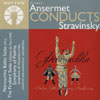Ansermet plays Stravinsky
Spirited, clear-headed performances captured in sound that, in its day, was considered state-of-the-art. Dutton’s transfers achieve considerable atmosphere and dynamic range
View record and artist detailsRecord and Artist Details
Label: Dutton Laboratories
Magazine Review Date: 2/2001
Media Format: CD or Download
Media Runtime: 0
Mastering:
ADD
Catalogue Number: CDBP9700

Author: Rob Cowan
‘A new and very exciting page in gramophone history’ was how Gramophone’s Alec Robertson described Ernest Ansermet’s first complete Petrushka. It was one of numerous accolades that celebrated expert use of the Kingsway Hall acoustic. Ansermet makes a beeline for the score’s darker voices (the bassoon comes off especially well), much as he did in his later recordings of the piece – though the clarinet squeals high above lower strings in ‘The Peasant and the Bear’. Instrumental perspectives are well caught in ‘The Moor’s Room’ and the dancing Coachmen’s build-up is very exciting.
Comparing this recording with a near contemporary under Stokowski finds Ansermet highlighting Petrushka’s hangdog demeanour, whereas the more virtuosic Stokowski is all fire, impulse and temperament. Both play the whole score, though Dutton refers to a ‘Petrushka Suite’ – which suggests less music than we actually hear. The 1919 Firebird Suite is supplemented by the ‘Princesses’ Dance with the Golden Apples’ that Stravinsky had included in his 1911 suite (he conducts the Dance on his own 1928 recording of the suite, Pearl, 1/92) and later worked into his suite of 1945 (his 1946 recording of which is available on Dante). Rather than incorporate the Dance into the main body of the suite, Dutton includes it as a sort of supplement – which is no great problem given the programming versatility of most CD players. Again, the performance displays clear thinking and quick reflexes, and the sound quality is far more dynamic than most productions of the period. The Symphony of Psalms, on the other hand, has a weighted, almost ritual quality (the chorus sounds fairly large), quite unlike the more ethereal approach favoured by various of today’s interpreters. Tempos are not dissimilar to Stravinsky’s own in his 1931 Champs-Elysees recording for Columbia/EMI (once available on Vogue), though the effect is a good deal less raw.
Dutton’s highly personal transfer technique is by now the stuff of legend. Certainly the manifest curve of dynamics – from pp to fff – could never have been achieved on playback equipment of the day. And while some might find the soft music a trifle murky (I personally would have preferred greater clarity at low level), no one could deny the impact of key climaxes, especially in the two orchestral works. With excellent presentation (contemporary reviews are usefully quoted) and attractive design, this super-budget release should find an enthusiastic audience.'
Comparing this recording with a near contemporary under Stokowski finds Ansermet highlighting Petrushka’s hangdog demeanour, whereas the more virtuosic Stokowski is all fire, impulse and temperament. Both play the whole score, though Dutton refers to a ‘Petrushka Suite’ – which suggests less music than we actually hear. The 1919 Firebird Suite is supplemented by the ‘Princesses’ Dance with the Golden Apples’ that Stravinsky had included in his 1911 suite (he conducts the Dance on his own 1928 recording of the suite, Pearl, 1/92) and later worked into his suite of 1945 (his 1946 recording of which is available on Dante). Rather than incorporate the Dance into the main body of the suite, Dutton includes it as a sort of supplement – which is no great problem given the programming versatility of most CD players. Again, the performance displays clear thinking and quick reflexes, and the sound quality is far more dynamic than most productions of the period. The Symphony of Psalms, on the other hand, has a weighted, almost ritual quality (the chorus sounds fairly large), quite unlike the more ethereal approach favoured by various of today’s interpreters. Tempos are not dissimilar to Stravinsky’s own in his 1931 Champs-Elysees recording for Columbia/EMI (once available on Vogue), though the effect is a good deal less raw.
Dutton’s highly personal transfer technique is by now the stuff of legend. Certainly the manifest curve of dynamics – from pp to fff – could never have been achieved on playback equipment of the day. And while some might find the soft music a trifle murky (I personally would have preferred greater clarity at low level), no one could deny the impact of key climaxes, especially in the two orchestral works. With excellent presentation (contemporary reviews are usefully quoted) and attractive design, this super-budget release should find an enthusiastic audience.'
Discover the world's largest classical music catalogue with Presto Music.

Gramophone Digital Club
- Digital Edition
- Digital Archive
- Reviews Database
- Full website access
From £8.75 / month
Subscribe
Gramophone Full Club
- Print Edition
- Digital Edition
- Digital Archive
- Reviews Database
- Full website access
From £11.00 / month
Subscribe
If you are a library, university or other organisation that would be interested in an institutional subscription to Gramophone please click here for further information.




